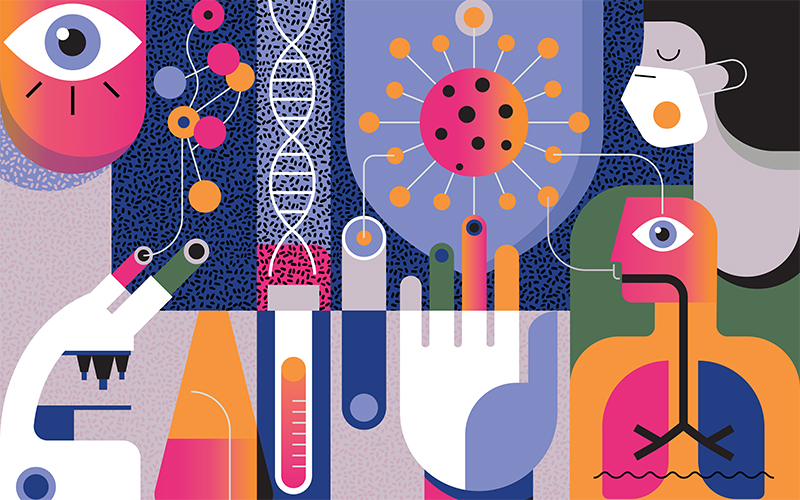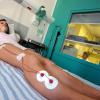On behalf of the members of the Molecular Pathology Advisory Panel, Chair Dr Andrew Blann introduces the new Specialist Diploma.

Few can argue with the growing importance of molecular genetics, and its development in the clinical world as molecular pathology. Over the last few years, the critical mass of both academic and practical aspects of this discipline has come together to justify a new Institute qualification – the Specialist Diploma. The Institute has recognised the need for a specialist advisory panel for this subject, which was formed in 2022. Its remit has been to put together a group of modules and, after a year’s hard work, these will be released and ready to go in February.
For whom is it written?
The Specialist Diploma is a specialised professional qualification for early career biomedical scientists. On achieving an IBMS Specialist Diploma, the candidate will be eligible to upgrade to a Member of the IBMS. However, we also recognise that many of our colleagues who are already Members or Fellows may be seeking, or perhaps have already made, a move into molecular pathology from another discipline. For those in this situation, the Specialist Diploma provides an easily accessible document showing proof of competency. In all cases, registration with the Health and Care Profession Council is mandatory, and the home laboratory must be approved by the IBMS for the purpose of training.
What is the format?
All Institute Specialist Diplomas follow a common pattern. The candidate will be assessed through a portfolio of experiential learning and presentation, as well as a laboratory tour and oral examination. Both will be undertaken by specialist portfolio examiners. This format will enable the candidate to demonstrate evidence of training, practical skills, specialist knowledge and competency gained in a chosen discipline against a benchmark standard for a specialist practitioner.
Exactly what are these modules?
These can be described in two groups: the technical and the clinical (see Table 1).
Table 1: Technical and clinical modules
Technical modules
Core genomics, quality, nucleic acid extraction and quantification, sample handling, karyotyping, in situ hybridisation, Sanger sequencing,
PCR and real-time PCR, microarray, next-generation sequencing, pyrosequencing, fragment analysis, high-resolution melt analysis
Clinical modules
Haematological malignancy, solid organ cancer, rare and inherited diseases
The former covers all the relevant methods in molecular pathology, the latter the application of those methods to our clinical practice. Each module has several learning objectives that provide the basis for the examination. The mandatory modules to be completed by candidates will include a quality module and there will be optional choices from the clinical modules that can be selected relevant to the scope of their practice. This format therefore ensures the scientist can tailor their portfolio for their individual laboratory practice. Each module will be freely available on an Institute website page: examples of a technical and a clinical module are provided in Table 2, below. However, we recognise the ever-changing face of the discipline, so modules may be amended, and others added, for infectious diseases, for example.
How does it work?
The procedure will be entirely website-based, using an online portal called “Brightspace”. This will enable the scientist, training manager and examiner to view all relevant documents and so keep an eye on the progress of the Diploma. The entire process is open-ended, and the candidate and their Training Manger can decide when they wish to formally apply.
When can I sign up?
We plan a launch date in February, at which point all details will be on the IBMS website.
Table 2: Example of module learning objectives
Module: Karyotyping
- Identify the key phases of the cell cycle required for karyotyping and their place in mononuclear leucocyte tissue culture.
- Define the underlying principles of karyotyping.
- Describe an appropriate process for obtaining banded metaphase chromosome preparations, identifying the key stages and reagents used.
- Outline, giving examples of particular disorders, the clinical need for karyotyping.
- Recognise common sex and autosome aneuploid abnormalities from a karyogram.
- With reference to other laboratory methods, describe the advantages and limitations of the karyotyping technique.
- Describe the most common chromosome banding techniques used in karyotyping, including C-, G-, Q- and R- banding, and their chemical basis.
- Perform G-banding on a range of samples and analyse the results.
- Discuss troubleshooting techniques to obtain optimum chromosome preparations for analysis.
- Evaluate the importance of internal and external quality assurance for karyotyping.
Module: Haematological malignancies
- Explain the principles of haematopoiesis from the multipotent stem cell to the mature cell. Consider both lymphopoiesis and myelopoiesis.
- Describe presenting clinical symptoms (constitutional features, TATT/ night sweats/ weight loss) and initial routine screening tests (FBC, CRP, LDH) that may raise suspicion of a haematological malignancy. Consider the differential diagnosis.
- Define the impact of sample type: consider peripheral blood, bone marrow trephine and bone marrow aspirate.
- Define common terminology used in FBC, blood morphology and bone marrow reports.
- Explain the importance of “Premalignant haematological conditions” for example, but not limited to: monoclonal B-cell lymphocytosis (MBL), monoclonal gammopathy of undetermined significance (MGUS), and clonal haematopoiesis (CH).
- Define the key features of myeloid neoplasms as a continuum of disease: MPN<MPN/MDS overlap>MDS<AML/MDS overlap> AML. Consider the current guidelines (WHO, ICC and NCCN) and how these are supported within the molecular laboratory.
- Define the key features of lymphoid neoplasms as B-cell and T-cell malignancies. Consider the current guidelines (WHO, ICC and NCCN) and how these are supported within the molecular laboratory.
- Describe the importance of molecular information in both the context of diagnosis, prognosis and treatment decision-making, and monitoring (MRD). Highlight the importance of a molecular service across the lifespan of the disease/ patient experience.
- Discuss the use of cross-discipline expertise to aid diagnosis. For example, how karyotyping, NGS and BM morphology assist in risk stratification for some patients.
- Describe the function of a range of named targeted therapies and explain how their efficacy is predicted by applied molecular testing.
The Molecular Pathology Advisory Panel members are Andrew Blann (Chair), Amy Newman (Deputy Chair), Amanda Corkhill, Robert Dunn, Matthew Griffiths, Isla Henderson Hunt, Richard Matthews, Katya Mokretar, Ben Poskitt, Gary Reynolds, and Joanne Watkins.
Image credit | iStock



